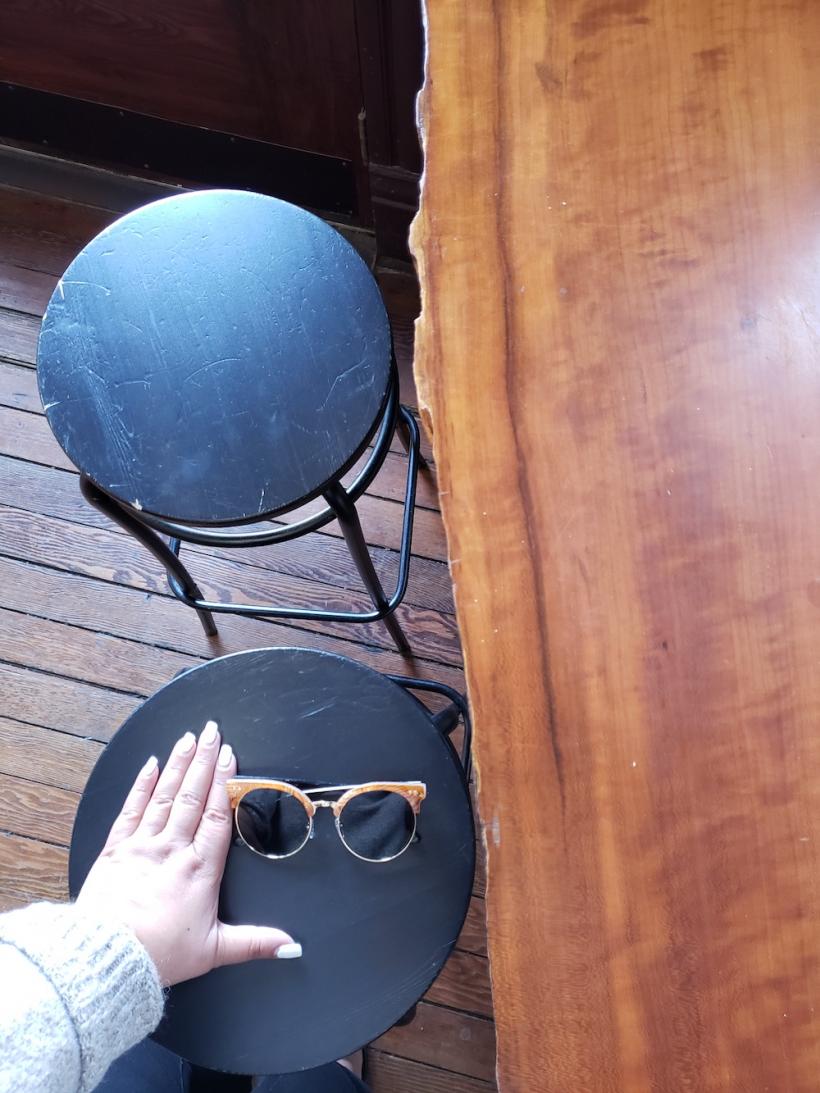
image credit Virgie Tovar
Last week’s New York Times article about the size restrictiveness of restaurant seating inspired me to dig through my archive of half-baked essays and finish the one about the struggles of being a fat woman who just wants to find a comfortable place to sit and have a snack in San Francisco, a city whose chic restaurants and cafes often prioritize design over comfort.
I can’t tell you how many times I have spent an entire hour leaning forward with my butt cheeks clenched just in case my gorgeous-yet-precarious chair decides to break and impale my vagina.
I can’t tell you how many times I’ve walked into a place with carefully constructed plastic chairs made by, like, a Swedish minimalist I’m sure, and that are so fragile that I can barely relax.
The lunch place up the street — where they lovingly cure their own pastrami — has these gorgeous chairs comprised of two very hard slabs of glossy oak held together by thick pieces of metal. The interior of the restaurant is entirely covered in wood paneling, and I’m sure it was designed to make the diner feel like she’s sitting inside a tree. And it’s about as comfortable as that experience must be.
Why, San Francisco?
When I tried to understand why there was an epidemic of very uncomfortable seating, I came up with some possible factors, and decided to focus on one: the design-consciousness that is unique to select cafes and eateries in a cosmopolitan and affluent city like this one.
I didn’t grow up in a wealthy city. My childhood was spent in a lower middle class suburb of the Bay Area. Chairs were not art objects. Like most things meant for people with limited budgets, they were created for the purpose of utility. I didn’t know about design until I moved to San Francisco. Yes, technically, design is all around us. We see it in the way magazines are laid out, in city planning, in stores. But what I’m talking about is a little different - curating a space in order to tell a unique story about who inhabits it. This kind of design is for the elite; it’s a spatial reminder of exclusivity and refined — or restrained — taste.
Minimalism is the height of symbolic restraint, and is a favored design choice in San Francisco.
Spaces that prioritize design — especially minimalism — can be uncomfortable. I wondered if my seating challenges had to do with the fact that discomfort feeds into the suffering-is-a-sign-of-success Protestant work ethic fetishized by the upper middle class. I wondered if I was yet again being penalized for not having a body that symbolizes that revered restraint.
I don’t think design is the only reason that a comfortable chair is hard to come by in my town, but it’s part of the reason that finding somewhere to sit presents a significant source of stress to someone like me.
You Might Also Like: Take The Cake: Fatphobia Isn't About Looks
For a fat person who has spent her whole life feeling too-big for most things, the experience of not being able to sit comfortably in a chair is familiar. Even though I’m pretty sure thin people don’t love attempting to eat while precariously perched on a high stool at a table that’s basically the size of a clipboard, their discomfort doesn’t register as a sign that they are unwelcome. Mine does. A lifetime of stigma pushes my brain to understand experiences through a particular lens. If I’m uncomfortable, it’s my fault, not the chair’s fault. This feeling of self-blame is an example of a stress response. Marginalized people experience stress responses when they are put into situations that remind them of their outsider status. It negatively affects the body, mind and spirit.
It’s important to recognize that tiny or unsupportive seats (no matter how beautiful) send a silent but powerful message about who has the right to sit down. This message has strong ripple effects for a community that is already facing quite a bit of discrimination.
For instance, when the seats in a cafe or restaurant cannot accommodate someone’s size, they may buy food or coffee there but can’t stay to enjoy it like a “regular” customer. They may end up taking their order to go, which means they may end up going home and eating alone, exacerbating the isolation that fatphobia already creates for them as a fat person.
I’ll speak for myself and say that as an independent contractor in a city full of entrepreneurs, it would be nice to be able to be part of the work culture I see all around me in cafes. I’m already an entrepreneur — in part — because of fatphobia in the corporate world. I’d love to grab my laptop and work for an hour while I drink coffee like my thin counterparts, but I sometimes find myself unable to find comfortable seating and consequently unable to concentrate. I don’t feel good about inviting my fat friends to most places in my neighborhood because I’m sure they’re going to be just as uncomfortable. This means we have to commute longer and farther away. This adds money, time and effort to outings.
These things just aren’t acceptable.
In short, design doesn’t have to come at the cost of utility, but when comfort becomes an access issue then we must begin making changes to design. For people who have perhaps never had to consider access — for whom most spaces are comfortable — they may not realize the impact their design decisions are having. When businesses make these design decisions they — perhaps — don’t realize they’re making a decision about who will opt in and who will opt out. Thin customers will likely make seating work because their bodies are both overtly and covertly welcomed everywhere. People like me, however, have a harder time making room.
We all have blind spots when it comes to creating access, but I think it’s worth it to ask ourselves where we navigate, who’s there, who isn’t and what we can do about it.








